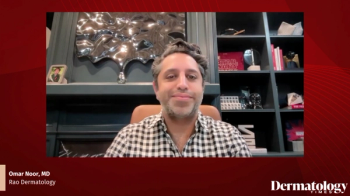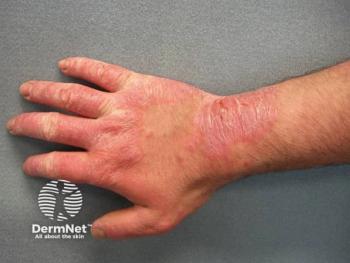
- Dermatology Times, New Directions in Topical Therapy for Atopic Dermatitis, October 2025 (Vol. 46. Supp. 07)
- Volume 46
- Issue 07
Clinical Community Forms Around Shared AD Challenges
Key Takeaways
- The roundtable event focused on complex AD cases, emphasizing treatment gaps, access barriers, and novel therapies' roles in management.
- Chronic AD cases highlighted the need for systemic therapy and addressed issues of undertreatment and outdated regimens.
At a recent Dermatology Times Case-Based Roundtable, attendees discussed several challenging AD cases.
At a recent Dermatology Times Case-Based Roundtable exclusive event discussing atopic dermatitis (AD) moderated by Adelaide Hebert, MD, the session brought together dermatologists, physician assistants (PAs), and nurse practitioners to dissect three nuanced cases—2 of which were drawn from Hebert’s own patient panel.
Far from being a standard lecture, this event fostered an environment where participants could explore gaps in treatment, barriers to access, and the evolving role of novel topicals and systemic agents in AD care. Hebert emphasized, “I think the sharing of our clinical experiences is very meaningful. I always learn something from the audience as well.”
Case 1: Chronic AD, Sleep Disruption, and Functional Impairment
The first case focused on a patient with longstanding uncontrolled AD, marked by visible excoriations and severe itch that interfered with sleep and work performance. “This patient did not, based on the photo, have very good control of his atopic dermatitis,” Hebert explained. “He was probably not easily able to apply topical agents just because of this anatomic region being affected.”
With documented involvement of approximately 15% of his body surface area (BSA), the patient met clinical thresholds for systemic therapy. As Hebert noted, “Once we get above 10% body surface area, we often go to biologic agents or JAK inhibitors... this patient would qualify at least clinically.” While systemic treatment was indicated, the conversation also explored why his prior therapies had failed and what psychosocial and functional factors might guide future care decisions.
The case also highlighted a common problem in dermatologic care—patients being undertreated or stagnating on outdated regimens. “It almost seems that this patient, at least to date, in the opinion of those attending, was undertreated or just inadequately treated overall,” she said.
Case 2: A 12-Year-Old with Head and Neck AD and Limited Prior Options
This case featured a pre-teen with AD affecting the head and neck—areas known to be both difficult to treat and emotionally impactful due to visibility and skin sensitivity. Although previously treated with topical agents, none had produced sufficient relief. As Hebert noted, “The topical agents prescribed before were not good enough, so this patient really wants to try something better.”
Importantly, the landscape of available therapies has changed. “Just since December of 2024, we’ve had some new agents available... this has really modified our capacity to consider topical therapy in this 12-year-old patient,” she said. New non-steroidal agents such as roflumilast and tapinarof—which are once-daily and without BSA restrictions—were discussed as strong candidates, as was ruxolitinib, with the caveat of a 20% BSA treatment limitation.
For systemic options, this patient, being 12, also qualifies for all 3 FDA-approved biologics for AD: dupilumab, tralokinumab, and lebrikizumab. But as with many pediatric cases, insurance coverage and the family’s openness to injectable therapies remained critical factors.
The discussion also touched on an important systemic issue: underrecognition and undertreatment of AD in primary care. The patient had not seen a dermatologist previously, based on a PCP’s belief that current treatment was adequate. Hebert addressed this frankly: “We see tremendous undertreatment by primary care physicians. We’re not criticizing them... they simply cannot access [certain medications] because of insurance limitations.”
Case 3: Skin of Color, Hypopigmentation, and Psychosocial Impact
The final case, also one of Hebert’s patients, involved a 9-year-old child of a higher Fitzpatrick skin type with visible hypopigmentation secondary to AD. While the underlying inflammation could be addressed, repigmentationlagged behind, leading to visible changes that provoked concern from the child’s peers and distress from the parents.
“This was disconcerting because of the cosmetic appearance,” Hebert said. “Even if the eczema gets under control, there seemed to be a lag in terms of the repigmentation.”
The group discussed several topical and systemic options—including dupilumab and emerging JAK inhibitors like ruxolitinib—as well as the limitations of age-based FDA approval and insurance criteria. Notably, Hebert emphasized the psychosocial stakes: “This child has clearly suffered both with disruption of sleep due to itch, but also the psychosocial implications that the loss of pigment has brought forward.”
She also pointed to new advancements: “There is now a validated scale for both increases and decreases in pigmentation in clinical trials for AD... I think this is something about which we are going to see considerably more data.”
Building Clinical and Educational Community
Hebert described the session as both an educational and community-building experience. “We really had very open-ended conversations,” she said. “And we also, because some of us have met a couple of times, it’s more becoming an educational community... the discussions, I think, flow even more freely, because people are not afraid to speak out.”
With participation from PAs, NPs, and dermatologists, the roundtable emphasized inclusion across professional roles. Hebert took care to engage each attendee personally, and the format encouraged real-time, practical discussion.
For Hebert, part of the session’s success came from being able to present her own patient cases, grounding the conversation in clinical reality: “I think that makes it real.”
Conclusion
The roundtable led by Hebert was a reminder of the clinical and emotional complexity inherent in treating AD—particularly in underserved or pediatric populations. It underscored the importance of broadening therapeutic strategies, incorporating new data, and engaging in collaborative discussion.
As AD treatments continue to evolve, sessions like this offer critical space for reflection, recalibration, and connection—making the path forward not only more evidence-based, but more humane.
Articles in this issue
Newsletter
Like what you’re reading? Subscribe to Dermatology Times for weekly updates on therapies, innovations, and real-world practice tips.



















